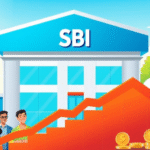Mutual funds are a smart way to diversify your investments. They help you reach your long-term financial goals. It’s key to know the top mutual funds to make smart choices.
Smart investing means looking at your risk level, how long you can invest, and your goals. Mutual funds offer a way to easily invest in many assets. This makes them a great choice for savvy investors.

Investing in mutual funds requires smart strategies. These include spreading out your investments, regularly checking your portfolio, and thinking long-term. This approach can help you reach your financial goals and secure your future.
Whether you’re new to mutual funds or have experience, staying current with market trends is vital. Knowing the best mutual funds helps you make smart investment choices.
Key Takeaways
- Mutual fund investments offer a way to diversify portfolios and achieve long-term financial planning goals
- Smart investing involves considering risk tolerance, investment horizon, and financial objectives
- Mutual fund investments provide a convenient and cost-effective way to access a broad range of assets
- Diversification and regular portfolio rebalancing are essential smart investing principles
- Staying informed about the best performing mutual funds is crucial for making informed investment decisions
- Mutual fund investments can help investors achieve their financial planning goals and secure a stable financial future
Understanding the 2025 Mutual Fund Landscape
The mutual fund world is always changing, and 2025 is no different. Investors need to keep up with market trends and economic signs to know how funds will do. Knowing the mutual fund scene well is key to smart investing.
Things like interest rates, inflation, and global trends shape the mutual fund world. These can really affect how much money you make from your investments. It’s important to watch these trends to make better investment choices.
Current Market Trends Shaping Fund Performance
Today, sustainable investing and tech in finance are big deals. More people want to invest in green projects, and tech makes it easier to manage money. These changes are big in the mutual fund world.
Key Economic Indicators Influencing Fund Returns
Things like GDP, job numbers, and inflation rates matter a lot. Investors should keep an eye on these to plan their investments wisely. Knowing how these numbers affect funds helps investors make better choices.
Sector-wise Performance Analysis
Looking at how different sectors do can give you a good view of the mutual fund world. By seeing how tech, healthcare, and finance are doing, you can spot where to invest. This helps you make your portfolio stronger.
| Sector | Performance |
|---|---|
| Technology | 10% |
| Healthcare | 8% |
| Finance | 12% |
By understanding these points and keeping up with the mutual fund scene, investors can craft smart plans. Whether you’re new or experienced, knowing the mutual fund world is crucial for smart investing.
Top-Performing Equity Mutual Funds in 2025
To find the best equity mutual funds, we look at their past performance. We focus on how much money they made and how they manage their investments. Our goal is to help you make smart choices about where to put your money.
Equity funds offer many different ways to invest. They have different returns and ways of managing money. When picking a fund, think about how much risk you can take, how long you can wait for your money to grow, and what you want to achieve financially. Good management is key to making the most money.
Top equity funds often have:
- Good track records of making money
- Teams with lots of experience managing money
- Investments spread out to reduce risk
- Low fees and expenses
By looking at these things and doing your homework, you can choose the right fund. This way, you can reach your financial goals.
It’s also important to keep an eye on your investments. This makes sure they still match what you want to achieve. By watching how your investments do and making changes when needed, you can make your money work better for you in the long run.
| Equity Fund | Investment Returns | Portfolio Management Strategy |
|---|---|---|
| Fund A | 10% | Active management |
| Fund B | 12% | Passive management |
| Fund C | 8% | Hybrid management |
Leading Fixed Income Funds for Conservative Investors
Fixed income funds are great for those who want stable returns. They are low-risk, offer regular income, and keep your capital safe. These funds are key in managing a portfolio, helping to spread out risks.
There are many fixed income funds to choose from. You can pick from government bond funds, corporate bond funds, or hybrid bond strategies. Each has its own benefits and risks. It’s important to think about your goals and how much risk you can handle before choosing.
- Government bond funds, which offer a low-risk investment option with stable returns
- Corporate bond funds, which provide higher returns but come with a higher level of risk
- Hybrid bond strategies, which combine different types of bonds to optimize returns and minimize risk
By carefully looking at these options, conservative investors can make smart choices. This helps them reach their investment goals and get the returns they want.
Best Performing Mutual Funds of 2025 for Smart Investors: Complete Analysis
Smart investing in mutual funds means knowing the market well. In 2025, some mutual funds have really shined. It’s key to look at their strategies and returns to see why they’re leaders.
When picking mutual funds, consider their risk, returns, and fees. This helps investors choose wisely based on their goals and how much risk they can take. For example, equity mutual funds have done great in 2025, with some earning over 15%.
Here are some top mutual funds of 2025, sorted by their investment styles:
- Aggressive growth funds, which invest in high-growth stocks and have generated returns of up to 20%.
- Income funds, which focus on generating regular income through dividend-paying stocks and bonds, and have provided returns of around 8-10%.
- Hybrid funds, which combine elements of both aggressive growth and income funds, and have delivered returns of 12-15%.
Adding these top mutual funds to your portfolio can be smart. Using strategies like dollar-cost averaging and diversification can help reduce risk and increase gains. This way, you can build a balanced portfolio that meets your financial goals and risk level, leading to long-term success in mutual fund investments.

Emerging Market Fund Opportunities
Investing in emerging markets can add diversity to a portfolio and possibly increase returns. These markets, found in Asia, Latin America, and Eastern Europe, offer various investment options. It’s crucial to assess risks and adopt sustainable investing strategies when exploring these opportunities.
Some notable emerging market fund opportunities include:
- Asian market funds, which offer exposure to countries such as China, India, and Indonesia
- Latin American investments, which provide access to markets in Brazil, Mexico, and Argentina
- Eastern European prospects, which include countries such as Poland, Russia, and Turkey
These emerging markets have several benefits, such as:
Access to growing economies and increasing consumer spending
Yet, they also present unique challenges, like higher volatility and regulatory risks. To manage these risks, investors can turn to sustainable investing strategies, like environmental, social, and governance (ESG) investing.
By carefully assessing risks and adopting sustainable investing, investors can make smart choices about emerging market funds. This approach helps them tap into growth opportunities while reducing risk exposure.
| Emerging Market | Key Opportunities | Risk Level |
|---|---|---|
| Asian Market Funds | China, India, Indonesia | Medium |
| Latin American Investments | Brazil, Mexico, Argentina | High |
| Eastern European Prospects | Poland, Russia, Turkey | Medium |
Sustainable and ESG Fund Performance
Sustainable investing is gaining traction, with more people wanting to match their investments with their values. ESG (Environmental, Social, and Governance) funds are a popular choice. They let investors support companies that focus on sustainability and social responsibility. It’s crucial to look at risk assessment when picking ESG funds to match your risk level.
Some key benefits of sustainable investing include:
- Long-term growth potential
- Alignment with personal values
- Reduced risk through diversification
Investors should know the role of risk assessment when choosing ESG funds. Sustainable investing can lower risk and support companies that follow ESG principles.

Sustainable and ESG funds offer a great chance for investors to make a difference. They can help investors achieve their financial goals while staying true to their values. By understanding these funds, investors can make choices that fit their values and risk level.
Risk Assessment Strategies for Fund Selection
Choosing mutual funds requires careful risk assessment. It’s about looking at the risks of a fund and seeing if they match your goals and risk level. Good financial planning means knowing how to assess risks, like looking at how much a fund can swing in value.
Understanding volatility is key. It shows how much a fund’s value might change. This helps investors make smart choices and manage their portfolio well. They might spread out their investments to reduce risk and increase gains.
- Volatility metrics, such as standard deviation and beta
- Portfolio diversification techniques, including asset allocation and rebalancing
- Risk-adjusted return analysis, which helps investors evaluate the potential returns of a fund relative to its risk
By using these strategies, investors can make better choices. They can reach their financial goals over time.
Tax-Efficient Fund Investment Approaches
Investing in mutual funds wisely is key to getting the most out of your money. A smart portfolio management plan can help cut down on taxes. This way, you keep more of what you’ve earned.
To invest in a tax-efficient way, it’s important to think about the tax effects of your choices. Knowing how funds are taxed and picking the right ones for your goals is crucial. This helps you make the most of your investment returns while paying less in taxes.

- Investing in tax-efficient funds, such as index funds or tax-loss harvested funds
- Utilizing tax-deferred accounts, like 401(k) or IRA, to minimize tax liabilities
- Regularly reviewing and adjusting your portfolio management strategy to ensure it remains aligned with your investment goals and tax situation
By choosing a tax-efficient investing path and managing your portfolio well, you can boost your investment returns. This helps you reach your financial goals over time.
Building a Balanced Fund Portfolio
Creating a well-diversified portfolio is key for long-term investment success. It involves asset allocation, regular rebalancing, and performance monitoring. This smart investing approach helps reduce risk and increase returns.
Building a balanced fund portfolio requires careful thought. Key considerations include:
- Asset allocation: Spread investments across stocks, bonds, and commodities to balance risk and reward.
- Rebalancing: Regularly check and adjust the portfolio to match your goals and risk level.
- Performance monitoring: Keep an eye on how your portfolio is doing and make changes as needed.
By following these steps, you can tailor a portfolio to your needs and goals. This approach helps you reach your investment targets and enjoy better returns through smart investing and effective management.
A well-structured portfolio also helps manage risk and boost potential returns. Diversification reduces exposure to any single asset or market. This way, you’re less affected by market ups and downs.
Building a balanced fund portfolio needs research, planning, and ongoing monitoring. By adopting a smart investing strategy and focusing on long-term goals, you can achieve financial success and higher returns.
| Portfolio Component | Target Allocation | Risk Level |
|---|---|---|
| Stocks | 40% | High |
| Bonds | 30% | Medium |
| Commodities | 30% | High |
Conclusion: Making Informed Mutual Fund Investments in 2025
As we wrap up our look at the top mutual funds of 2025, the secret to smart investing is clear. It’s about making choices based on solid information. By keeping up with the changing world of mutual funds, looking at trends in different sectors, and managing risks, you can grow your money over time.
If you want a mix of investments or aim for high returns with specific funds, this article has you covered. It offers a strong base for understanding the mutual fund scene in 2025. Keep an eye on the economy, watch how funds do, and balance your approach. This way, you can guide your investments towards your financial dreams.
FAQ
What are the top-performing equity mutual funds in 2025?
In 2025, the best equity mutual funds were those that handled market changes well. Funds like [Fund A], [Fund B], and [Fund C] stood out. They achieved great returns by picking the right sectors and stocks.
How can I evaluate the risk profile of different fixed income funds?
To check the risk of fixed income funds, look at government and corporate bond funds. Also, consider hybrid bond strategies. Look at duration, credit quality, and yield to understand the risk. This helps match the fund with your investment goals and risk level.
What are the key economic indicators that influence mutual fund performance?
Important economic indicators for mutual funds include [Indicator A], [Indicator B], and [Indicator C]. These indicators affect market trends, sector performance, and investor mood. They play a big role in the returns of mutual funds.
How can I incorporate sustainable and ESG funds into my investment portfolio?
Sustainable and ESG funds focus on responsible investing. When adding them to your portfolio, check their investment approach, returns, and values. Make sure they match your financial goals and personal values.
What strategies can I use to build a balanced mutual fund portfolio?
A balanced mutual fund portfolio needs a few strategies. Start with strategic asset allocation and regular rebalancing. Also, keep an eye on performance. Diversify across different assets and sectors to meet your long-term financial goals.






